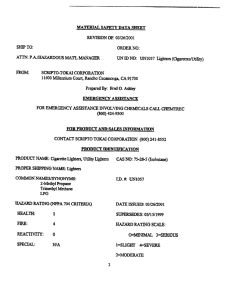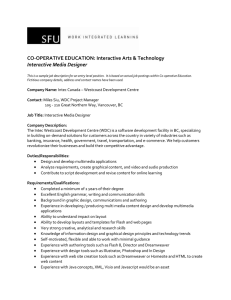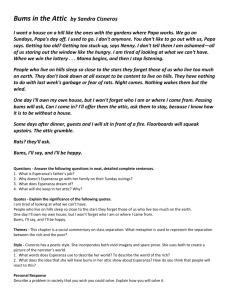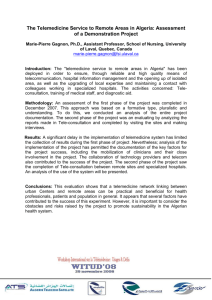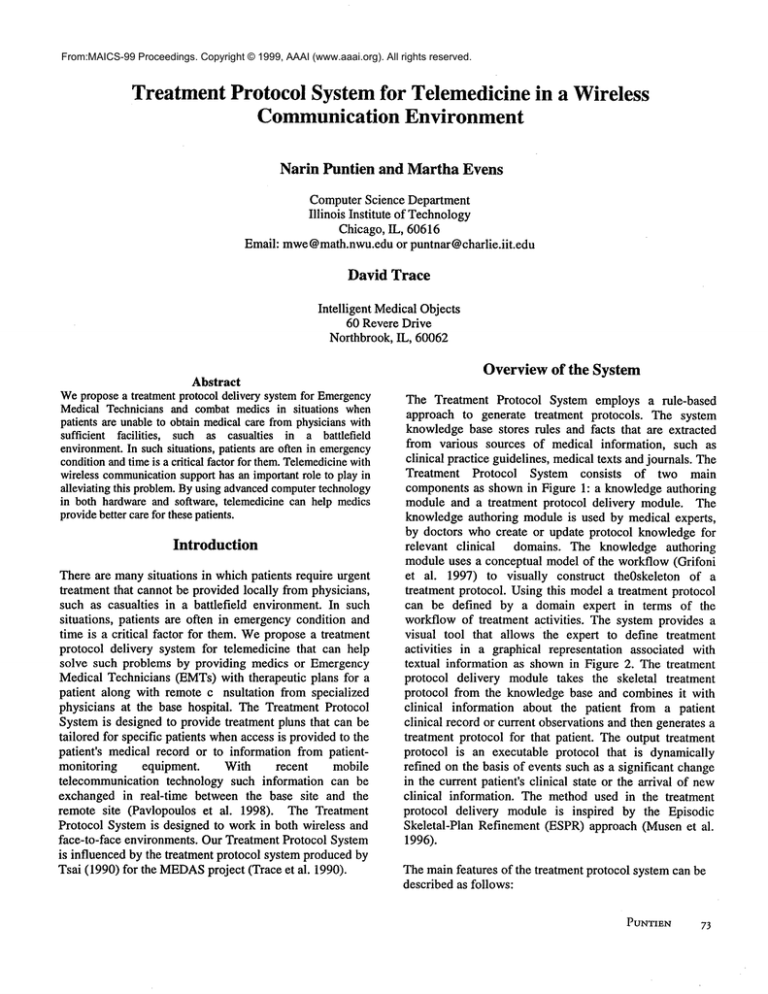
From:MAICS-99 Proceedings. Copyright © 1999, AAAI (www.aaai.org). All rights reserved.
TreatmentProtocol System for Telemedicine in a Wireless
Communication Environment
Narin Puntien and Martha Evens
Computer Science Department
Illinois Institute of Technology
Chicago, IL, 60616
Emaih mwe@math.nwu.eduor puntnar@charlie.iit.edu
David Trace
Intelligent MedicalObjects
60 Revere Drive
Northbrook, IL, 60062
Overview of the System
Abstract
Weproposea treatment protocol delivery systemfor Emergency
Medical Technicians and combat medics in situations when
patients are unable to obtain medicalcare fromphysicians with
sufficient facilities, such as casualties in a battlefield
environment.In such situations, patients are often in emergency
conditionand timeis a critical factor for them.Telemedicine
with
wireless communication
support has an importantrole to play in
alleviating this problem.Byusing advancedcomputertechnology
in both hardwareand software, telemedicine can help medics
providebetter care for these patients.
Introduction
There are manysituations in which patients require urgent
treatment that cannot be provided locally from physicians,
such as casualties in a battlefield environment. In such
situations, patients are often in emergencycondition and
time is a critical factor for them. Wepropose a treatment
protocol delivery system for telemedicine that can help
solve such problems by providing medics or Emergency
Medical Technicians (EMTs)with therapeutic plans for
patient along with remote c nsultation from specialized
physicians at the base hospital. The Treatment Protocol
System is designed to provide treatment pluns that can be
tailored for specific patients whenaccess is provided to the
patient’s medical record or to information from patientmonitoring
equipment.
With
recent
mobile
telecommunication technology such information can be
exchanged in real-time between the base site and the
remote site (Pavlopoulos et al. 1998). The Treatment
Protocol System is designed to work in both wireless and
face-to-face environments. Our Treatment Protocol System
is influenced by the treatment protocol system produced by
Tsai (1990) for the MEDAS
project (Trace et al. 1990).
The Treatment Protocol System employs a rule-based
approach to generate treatment protocols. The system
knowledgebase stores rules and facts that are extracted
from various sources of medical information, such as
clinical practice guidelines, medical texts and journals. The
Treatment Protocol System consists
of two main
components as shown in Figure 1: a knowledge authoring
module and a treatment protocol delivery module. The
knowledgeauthoring module is used by medical experts,
by doctors who create or update protocol knowledge for
relevant clinical domains. The knowledge authoring
moduleuses a conceptual model of the workflow(Grifoni
et al. 1997) to visually construct the0skeleton of
treatment protocol. Using this modela treatment protocol
can be defined by a domain expert in terms of the
workflow of treatment activities. The system provides a
visual tool that allows the expert to define treatment
activities in a graphical representation associated with
textual information as shown in Figure 2. The treatment
protocol delivery module takes the skeletal treatment
protocol from the knowledge base and combines it with
clinical information about the patient from a patient
clinical record or current observations and then generates a
treatment protocol for that patient. The output treatment
protocol is an executable protocol that is dynamically
refined on the basis of events such as a significant change
in the current patient’s clinical state or the arrival of new
clinical information. The method used in the treatment
protocol delivery module is inspired by the Episodic
Skeletal-Plan Refinement (ESPR) approach (Musen et
1996).
The main features of the treatment protocol system can be
described as follows:
PUNTIEN
73
¯
¯
Text Retrieval
System
Medical Texts & Journals
Clinical Guidelines
tment Protocol
Toolbox
UserInterface
Domain
experts
¯ Keyboard
Mouse
Graphical
display
¯ Voiceinput/output
ActionFlowDiagram
Rules& ObiecLs
ises
Multimodal
UserInterface
¯
¯
¯
Doctors
MASH
Emergency room
Clinical
Record
TreatmentProtocol
Delivery Toolbox
¯ Keyboard
Mouse
Graphical
display
¯ Voice inpuVoutput
Treatment
protocol
skeletonfor a
specific patient
Executable
treatment protocol
for a specific
patient
Realtime treatment
protocol refiner and
generator
Synchronizer
&Controller
~
i
~Communitition
Media
+
Synchronizer & Controller
¯
¯
Medics
EMT
VoiceinpuVoutput
Figure1. TheTreatment
ProtocolSystem
Architecture.
74
MAICS-99
i!
~
Figure2. TheExample
of a FlowDiagram
of Treatments
for Burns( Source:RegionHospital
Emergency
MedicalServices,Availableat URLhttp://www.regionsems.net).
PUNTIEN
75
1. The systemprovides a treatment protocol in the form of
a sequence of medical actions that EMT’sor medics can
easily follow. The systemwill track the user actions so the
users will always knowwhat has been done anl9 what to do
next.
2. The system utilizes clinical practice guidelines as the
main source of the system knowledge. The treatment
protocol authoring tool described earlier captures the
guideline content and logic in a form understandable to the
systemand uses it to generate treatment protocols.
3. The system interacts with the Medical Record System
directly. Clinical data can be acquired from and submitted
to the Medical Record System. The Treatment Protocol
System will be able to display the medical records with
analyzed clinical data in the form used by the front end of
the Medical Record System. The integration of medical
record information into telemedicine also brings up
important considerations of confidentiality and privacy
issues if the information is transmitted over a public
network(Richardsonet al. 1996).
4. The system uses a controlled medical vocabulary that is
widely accepted by many other institutions.
This will
allow the system to exchange comprehensible knowledge
with other medical systems remotely.
5. The system provides multimodal user interfaces as the
front-end componentto interact directly with the user. In
addition to ordinary I/O systems (e.g., mouse, keyboard,
display monitor and printer) a speech recognition systemis
also provided to allow voice data entry and voice output
for the system. Thevoice interface capability will be useful
for most health care providers whoare rarely accustomed
to using a keyboard or mouse and whousually need their
hands to do other more important tasks in emergency
situations.
are space consuming, which can strongly affect
performance when files are transferred between sites, we
rely heavily on advancedtransmission techniques.
8. The system has internet/web connectivity wkth access to
medical information provided by many worldwide web
sites. The system may also use the internet/web as a
communication mediumfor connecting with some of our
remotesites.
System
Components
The system consists of two parts: one is resident at the
main computerat a base hospital or other central site and
the other is resident at a remotesite on a battlefield or in a
helicopter or an ambulance.At the mainsite the system is
connected to the central databases directly and is able to
access remote databases in other institutions by existing
media, e.g., over telephone lines or the internet. The
system at the main site provides the patient’s history
information. At the remotesite, the systemis connected to
medical equipmentthat provides current information about
patient’s condition. The systems at both sites will exchange
information about the patient.
The program instance at the remote site is used by the
medic who provides treatment to the patient. In the
meantime a physician or nurse using the instance at the
central site can observe the procedures at the remotesite,
can send messages, and can override the treatment protocol
suggested by the system or bring up another one on the
remote screen. Although the remote site instance can
operate independently if communicationis lost, the system
is much more effective
when synchronization
is
maintained betweenthe two sites.
Knowledge
Engineering
6. The system provides a visual environment that can
display a graphical representation of system knowledgeto
users. Someof knowledge elements may have associated
graphical representations (e.g., treatment protocol objects
can be shownas a flow diagram, and an object hierarchy
can be shown as a tree structure.) However, the text
representation can be shown alongside its associated
graphical representation. Each graphical representation is
displayed in its own windowand has its owninterface to
users.
Because of the complexity of the available practice
parameters and the multiple sources of knowledgein our
medical domain, the process of building or updating a
treatment protocol for a specific domainis divided into two
mainsteps. In the first step the Text Retrieval System(see
Figure 1) helps the domainexpert to identify all relevant
information in the source text (which may be an AMA
practice guideline, a medicaltextbook or a journal article).
The second step contains t~e actual construction of the
protocol (or modification of the existing protocol) with
support from the system.
7. The system is multimedia-capable. Therefore images,
sound, animation, and video are supported in the system.
This feature is necessary because much medical
information is in multimedia form beginning with
radiographic images. Since most multimedia file formats
In the first step, the Text Retrieval Systemgenerates an
index of medical terms from the medical sources chosen;
they may be online or locally available. The system then
provides the domainexpert with a search engine that can
76
MAICS-99
retrieve related information about one or several given
terms. By the time this phase is over, the domain expert
has identified and collected together the pieces of text
containing the information that s/he wants to use in
constructing the protocol.
In the second step, with the information found using the
Text Retrieval System as a guide, the domain expert
actually builds the treatment protocol for a specific domain
(or modifies an existing protocol). To support the expert
this phase we provide the Treatment Protocol Authoring
System.
The Treatment Protocol Authoring System employs an
object-oriented approach to model real world facts. Facts
and rules in the rule-based modelare represented as several
classes of objects, e.g. rule objects and protocol objects.
Somenecessary classes of objects are predefined by the
¯ system and are ready to be used by users. The domain
expert mayhave to knowa little more about the objectoriented approach if they want to define a new class or
extend the existing class. To make the task of knowledge
construction more comfortable for the expert the Treatment
Protocol Authoring System provides a tool to represent
some object classes in their associated
graphic
representation. After the domainexpert finishes creating
the treatment protocol, the protocol knowledge is then
stored in the knowledge base and is later used by the
Treatment Protocol Delivery System.
Weare just starting to build this part of the system and
there are significant knowledgeengineering problemsstill
to be solved.
Knowledge
Representation
Rule-based and object-based models are used to represent
our system knowledge. Since the rule-based approach is
employed in our system as the main problem solving
method, production rules are necessary as the key
knowledge elements for the inference engine. However,
production rules alone do not have adequately expressive
power to represent complex domain knowledgesuch as the
knowledgein a clinical context. The object-based model
has an advantage in structural and organizational behavior
over the rule-based model. So we will use the object
concept to abstract domain knowledge into hierarchical
objects, whereas the rule-based model is used to add the
operational knowledgethat controls the state and behavior
of the objects.
Eachobject in the clinical context (e.g., patient, disease,
symptom,and treatment) can be defined in an object class
that contains attributes and operations. Objects mayhave
relations to each other. All necessary objects in clinical
context will be predefined in the system. However, the
expert can define newobjects by establishing subclasses of
predefined.classes.
The treatment protocol system is a rule-based expert
system. The system knowledgeconsists of rules that are
extracted from clinical practice guidelines, medical texts or
journals. In our system, rule premises and actions can be
defined as the expression of object attributes from defined
classes. The domain expert can also define rules as
preconditions of a class operation. By using rules and facts
(e.g., patient clinical information) the inference engine can
modifythe treatment protocol for a particular situation or a
particular patient. Figure 3 shows the diagram of some
objects in clinical context. The circular blocks denote
classes and the rectangular block denote their attributes.
A major focus of our work is how to display rules and
supporting diagrams or pictures on the screen in a form
that is easy to use in stressful situations. Figure 4 shows
some sample rules extracted from practice guidelines for
burns and some respiratory signs and symptoms. Which
rule for burns is displayed will dependon what the system
knowsabout the patient’s injury or drug allergies. The
object-oriented representation of rules can be represented
as shownin Figure 5.
The medic can click on an unfamiliar nameor abbreviation
to get an explanation, but we plan to use the standard
vocabulary for emergency medicine developed at Medical
College of Wisconsin so that we expect that this will
happen rarely. The user can indicate with a single click
whether s/he has decided to perform a suggested action or
not.
Conclusions
The treatment protocol system described here is an
ongoing project. Weare attempting to build a medical
system that takes advantage of the current advanced
technologies in telecommunication, multimedia, and
modernuser interfaces. While the main task of the system
is to provide treatment protocols to medical personnel who
take responsibility for patients in emergencysituations, we
have also focussed on improving the human-computer
interface of the system. Wehave many plans for future
improvements. Since the system is usually used in
stre{ ful envmronments where manual procedures, such
as data entry, are likely to be error-prone (Petroni et al.
1991), advancedusgr interfaces like voice input or better
screen design can increase the accuracy of humantasks.
Our system will have the ability to accept human-voice
commandsand to generate spoken output. This will free
the user to use his hands in other important tasks.’&It will
also be useful in the dark. Wehope to test the system at
Cook County Hospital. Weneed to observe real users in
the field in order to evaluate the system.
PUNTIEN
77
Relation
.as
(,~Patient
j) ................................ "[,,,~
’<’, "-v---"-
ulsease .~)
Name, I ~’ ....
I Symptoms&Signs
I Name, I ~-"
I Name IicD_9Code
,
}
~.~
Type J
!nstan!!a!e’--1 TreatmentI
Name [ ~p’~~
.............
Figure3. A Diagram
of Some
Objectsin a Clinical Context.
RULE-1
IF
1) Patient has bums, and
2) Bumtype is Chemical bums,
THEN 1) Perform BLS, and
2) Washbumarea with copious amounts of water or NSfor 20 minutes.
RULE-2
IF
1) Patient has bums, and
2) Burn type is Chemical bums, and
3) Bumarea is eyes,
THEN 1) Perform BLS, and
2) Irrigate burn area with copious amountsof NSuntil the patient reaches the hospital.
RULE-3
IF
1) Patient has bums, and
2) Bumtype is Inhalation bums,
THEN 1) Perform BLS, and
2) Reassessfrequently and consider the need for early intubation, and
3) Perform BLSwith variance or ALSand consider albuterol neb for bronchospasm.
Figure4. Sample
Rulesfor BurnsExpressed
in English.
Defrule (Patient.HasDisease.Name("bums")and Patient.HasDisease.Type("Chemical
bums")
=> Perform( Burns.Treatment.Context("BLS"));
Perform( Burns.Treatment.Action("WASH_1")))
Note: WAHS_I
is a new defined action for washing burn area with copious amounts of water
or NSfor 20 minutes.
Figure_5.TheRepresentationof Rule-1in Object-OrientedForm.
78
MAICS-99
Acknowledgments
Wewant to thank the U.S. Armyfor support via contract
DLA-900-93-D-0011
with Illinois Institute of Technology
ResearchInstitute.
References
Grifoni, P., Luzi, D., Merialdo,P., &Ricci, F. L. (1997).
ATREUS:
A Model for the Conceptual Representation of a
Workflow.Proceedings of the Eighth International
Workshopon Database and Expert Systems Applications,
400-405.
on Information Technology Applications in Biomedicine,
150-154.
Petroni, M., Roger, K., Collet, C., Fumai, N. &Malowany,
A.S. (1991). An Automatic Speech Recognition System for
Bedside Data Entry in an Intensive Care Unit. Proceedings
of the 33rd Midwest Symposiumon Circuits and Systems,
791-794.
Richardson, I. E. G., Riley, M. J., Haston, W., &
Armstrong, I. (1996)Telemedicine and Teleconferencing:
The SAVIOUR
Project. Computing & Control
Engineering Journal, 2, 21-26.
Musen,M. A., Tu, S. W., Das, A. K. &Shahar, Y. (1996).
EON:A Component-Based Approach to Automation of
Protocol-Directed Therapy. JAM1A,3, 367-388.
Trace, D., Evens, M., Naeymi-Rad,F. & Carmony,L.
(1990). Medical Information Management: The MEDAS
Approach. Symposiumon ComputerApplications in
Medical Care, Washington, DC, 635-639.
Pavlopoulos, S., Kyriacou, E., Berler, A. &Koutsouris, D.
(1998). A Mobile System for EmergencyHealth Care
Provision Via Telematics Support- "AMBULANCE".
ITAB98Proceedings 1998 IEEE International Conference
Tsai, C. A. (1990). TreatmentProtocols for a Medical
Expert System: Solving Problems in Text Delivery and
KnowledgeEngineering. Ph.D. Dissertation, Computer
Science Department,Illinois Institute of Technology.
PUNTIEN
79

